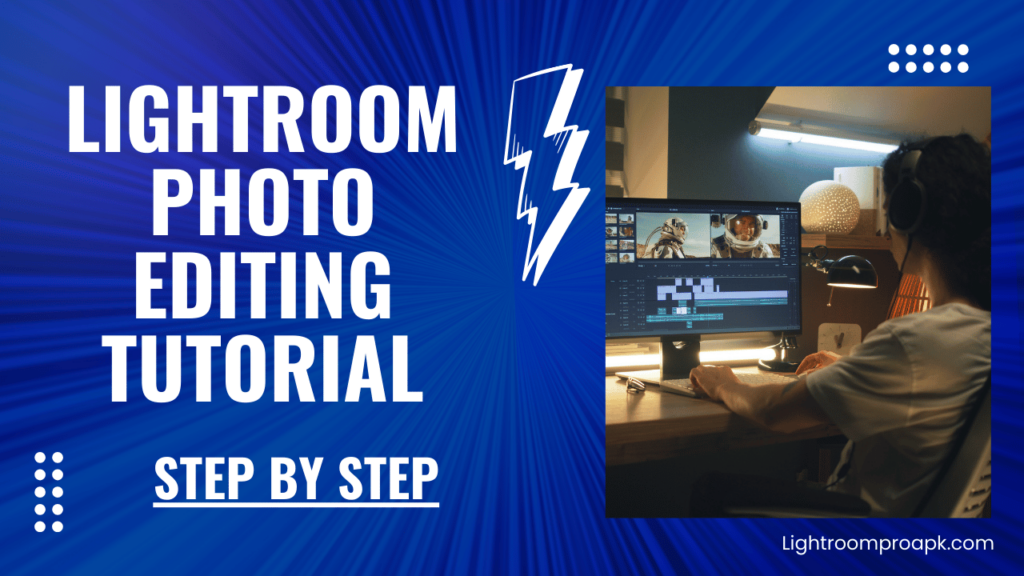Proper Guidance of Lightroom Photo Editing Tutorial Step-by-step Tips [2025]

Lightroom has a variety of features that allow editors to edit various aspects of their photos, such as exposure, color balance, contrast, and sharpness. It is designed to manage large collections of images and the complete process of importing, organizing, editing, and exporting them. Making amazing photos using Lightroom Photo editing features has been a major topic of discussion.
In this article, we will look at how to edit photos efficiently using Adobe Lightroom. This application helps you to edit using both the application and online resources provided by Adobe in the form of Lightroom.
This is a type of application that can be used by both experts and beginners. The Lightroom development team’s ability to make this application more user-friendly and smooth is an example of their great work.
Why Lightroom Photo Editing tutorial?
Lightroom photo editing is popular among experts for several reasons. Firstly, it has a complete set of powerful editing tools and features that help with precise editing and enhance the overall photo quality. Its non-destructive editing feature protects original images, enabling users to revert them at any time without losing quality.
Lightroom manages and organizes large photo collections, making it easy to sort, tag, and locate photos quickly. They have built-in presets and filters to help users. It is a cloud-based editing application that keeps editing files very safe. That is why, you can get access it from any device at any time. This creates an editing process that makes your work more exciting. On the other hand, it can be used on Mobile, PC/desktop, and iOS devices, with data stored in the cloud.
How to edit Photos by using Adobe Lightroom?
Editing photos with Adobe Lightroom is a structured process to improve the quality and beauty of your images and helps you to photo edit from any device. This approach teaches you to properly use Lightroom to transform your photos into amazing visual works of art. As a professional photo editor, you should be required to capture your photos with smart cameras. It is very important to consider the role of your phone’s camera.
To edit your photos with Lightroom, follow these simple steps:
Step 1: Import Your Photos
Open Lightroom: To begin editing in Adobe Lightroom, first, open the app on your desktop or mobile device. Make sure you have the latest version installed for best performance. it is the first step to complete the Lightroom photo editing process. You should open the Lightroom application (if not downloaded, get it from our site).
Import Photos: In the Import section, select the photos you want to import by clicking on them individually or using the Shift key to make several non-contiguous selections. Make sure you are only editing one picture at a time. Review the import settings to decide whether to copy, move, or add the photos for backup purposes. The use of a healing brush can provide amazing changes such as hiding black spots, etc.
Organize: Specify the folder and organize them into subfolders based on date or other criteria. Add details and keywords to help you organize and search later. Make it easier to find your images by organizing them into folders, albums, or collections. Once imported, your photos will be displayed in the Library area.
Step 2: Basic Adjustments
Exposure: Begin your photo editing process with basic adjustments to set the foundation for more detailed edits. Start with the Exposure to correct the overall brightness of your photos. Adjusting the exposure is always better than using an accurate level of brightness. Having too much brightness also creates dull results. So, there is a need to select an accurate brightness slider setting. I always use values between +.5 to +1.0. These values create some better results as well. The exposure or brightness of any picture matters a lot.
Contrast: Next, focus on Contrast to improve the visual impact of your photos. Increasing the contrast makes the lighter areas lighter and the darker areas darker, which adds depth to the image. Carefully adjust the contrast to maintain a natural appearance while improving its appeal.
Highlights and Shadows: Fine-tune your image’s details by adjusting the Highlights and Shadows. Modifying the highlights allows you to recover details from your photo’s bright areas. These adjustments create a well-rounded photo with a full range of visible features, ensuring that no section of the image is too bright or dark.
Whites and Blacks: Adjusting the Whites and Blacks is essential for fine-tuning the tone range of your photo. The white slider changes the brightness of the lightest areas, while the black slider adjusts the depth of the darkest areas. Balancing these sliders improves the contrast and depth of your photo, providing a visually appealing result.
Step 3: Color Adjustments
Temperature and Tint: They help to achieve accurate color balance and mood. The Temperature slider adjusts the warmth or coolness of your photo, which can have a major impact on its overall tone. To correct color casts, use the tint slider together with temperature adjustments. You can also use the color tool to make some new changes like the hue, saturation, and brightness of each color in the photo. Make sure you have a balance between these fixtures.
Vibrance and Saturation: Vibrance adjusts the more muted colors without affecting the already vibrant ones, making it ideal for keeping skin tones from being saturated. Saturation, on the other hand, adjusts the overall strength of all colors in photographs. Together, these changes allow you to modify the color dynamics of your photo, ensuring that it expresses the right mood and visual effects.
Step 4: Detail Enhancements
Sharpening: Sharpening improves the edges and fine details of your image, making it more unique. To sharpen your photo, use the Sharpening slider in the Detail panel. The Masking slider can help to prevent sharpness from affecting areas with smooth tones, such as skies or skin, by applying the effect only to the edges.
Noise Reduction: This helps to smooth out unwanted digital noise. Noise appears as random speckles or graininess which can degrade the photo’s quality. Color Noise Reduction reduces color noise, which appears as colored spots or pixels. By carefully balancing sharpening and noise reduction, you can improve the clarity and quality of your photo while maintaining its natural look and feel.
Step 5: Creative Adjustments
Filters and Presets: Lightroom has presets and Filters that apply specific effects or colors to create a desired look or style, such as adding a vintage mood or increasing contrast. Using or creating presets and filters is simple, select a preset from the list, and it will apply a combination of edits to your photo, which you can further adjust if needed.
Crop and Straighten: The Crop feature helps you to remove unwanted edges and improve the framing of your photo. Adjust and use the aspect ratio setting to maintain specific dimensions if required. The Straighten feature corrects tilted or skewed angles by adjusting the horizon or vertical lines in the photo. To straighten an image, simply drag the slider or use the crop overlay.
Lens Corrections: This process compensates for common lens issues and improves image quality by ensuring that straight lines and colors stay accurate. These creative adjustments improve your photo’s composition, style, and technical quality, resulting in a polished and visually appealing image.
Step 6: Advanced Techniques
Graduated Filter: This is perfect for making gradual adjustments to a photo’s exposure, color, or other settings over a linear area. It’s particularly useful for improving skies, landscapes, and any photo with a clear transition between features. Drag the Graduated Filter across the area you want to edit, then adjust the filter settings to gradually apply the changes.
Radial Filter: They enable you to make circular or elliptical adjustments around the area of your photo that you want to edit. This creates a vignette effect, or applying localized enhancements. To use the Radial Filter, simply adjust the settings within that shape, such as exposure, contrast, or clarity to easily highlight important features and create artistic effects.
Adjustment Brush: The brush allows you to make precise, localized edits on specific areas of your photo. You can customize the brush’s size, feathering, and the intensity and smoothness of your adjustments. This feature is for retouching, boosting, or correcting color with a high level of control, resulting in a polished end result without affecting the entire image.
Step 7: Final Touches
Spot Removal: The final touches on your photo Spot Removal is used to clean up minor imperfections, such as dust spots, blemishes, or other unwanted features in your photo. You can select between the Clone and Heal modes. Clone replicates the exact pixels from the sampled area, while Heal blends the sampled pixels with the surrounding tones and textures for a more natural look. This tool is especially useful for portrait retouching, landscape cleanup, and overall photo organization.
Vignette: A vignette, that darkens or lightens the edges of a photo, can gradually draw attention to the main point. This effect helps to focus the viewer’s attention and adds a professional touch. A simple vignette can improve the composition by adding depth, creating a more interesting and visually appealing image.
Step 8: Export Your Photos
Export Settings: After you have completed editing your photos, the final step is to export them with the proper settings to optimize them for different uses, such as web display, printing, or social media sharing. Start by selecting the Export Location, which determines where the files will be saved on your computer. If you need to rename your files for better organization or consistency, then choose File Naming.
Rename and Organize: Properly organizing your exported photos will save you a lot of time in the future. You can rename your photos in the export settings using custom templates including date, sequence number, or custom text. This will make it easier to find and organize your photos later.
Step 9: Share and Backup
Share: The Lightroom photo editing process should be so accurate to get some extraordinary results. You can now export your photos from Adobe Lightroom. You can also share these photos to post on any social media profile and sharing them with your audience or clients is the next important step. Lightroom provides several options for sharing directly from the application. You can easily upload your photos with a few clicks. Whichever method you choose, ensure your photos are optimized for the specific platform to maintain their quality.
Backup: Properly backing up your photos is important for protecting your work from data loss. After exporting, use cloud storage services such as Google Drive, Dropbox, or Adobe Creative Cloud to create an offsite backup solution. These services offer automated backup options, ensuring that your files are regularly updated and accessible from anywhere.
FAQ’s
Conclusion
This article will help you put great effort into the Lightroom photo editing tutorial. To make the most of the editing process in Lightroom, Follow the basic tips listed above. You can edit your projects without any loss of work because it provides a non-destructive editing process. This way, you can improve your creativity and precision when editing photos with Lightroom. So, to use these simple methods, download the Lightroom mod APK latest version 2025 from this website.
I hope this blog post has helped you understand how to download Lightroom for iOS. If you have any problems, please contact our team of Lightroom experts will always be there to help.
Disclaimer
We have also discussed the top features of Lightroom MOD APK, which make it unique compared to other video editing apps. Other video editing apps need to provide us with premium features like Lightroom.


